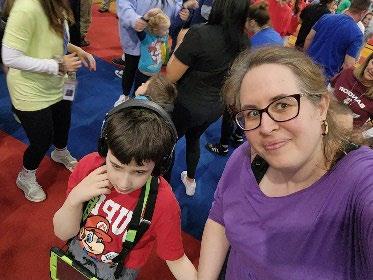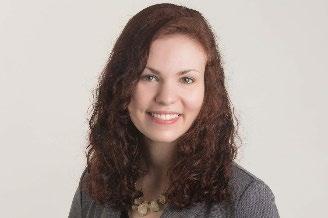

ABSTRACT
Through personal management experience and overall knowledge of Devereux employees, it was discovered that there is a high population of Neurodivergent individuals that work as employees to care for the organization’s patient population, who are 100% Neurodivergent. These employees often felt they were alone in their Neurodiversity without peer support from colleagues. A Neurodiversity ERG was created as a pilot to offer these employees and any allies a safe place to discuss their experiences, build community and share resources. The following information discusses the journey from inception in November 2023 to present day.
BACKGROUND
Devereux Advanced Behavioral Health is a 112-year old mental and behavioral health organization that serves many of our country’s most vulnerable populations in the areas of autism, intellectual and developmental disabilities, specialty mental health, education and foster care. Devereux's continuum of care expands from birth to end of life. Founded in 1912 by special education pioneer Helena Devereux, Devereux operates a comprehensive network of clinical, therapeutic, educational and employment programs and services that positively impact the lives of tens of thousands of children, adults –and their families – every year. The organization’s unique approach combines evidencebased interventions with compassionate family engagement.
In November 2023 Devereux began an employee resource group (ERG) for Neurodiversity An ERG is a voluntary employee-led group that fosters a diverse inclusive workplace, created and facilitated by Neurodiverse employees FOR Neurodiverse employees. Because we are a mental and behavioral health organization, many of our employees directly care for individuals who are also Neurodiverse but who require much higher levels of support. Neurodivergent individuals struggle to gain and maintain employment (Dunne, 2023) Those who are employed are often pressured to hide in plain sight (mask) to fit in to work culture to stay employed and maintain security. The long-term toll on Neurodivergent individuals can be complex, serious and traumatic if they aren’t given a space within their work environment to be accepted and celebrated for the strengths and talents they bring Shame and isolation are contributors to the mental health toll. Neurodivergent individuals have elevated risk for suicide, with increasing risk for women, those with higher IQs, and with combined diagnoses (Fuller-Thomson, Rivière, Carrique, & Agbeyaka, 2022) (Casten, et al., 2023) (Kõlves, Fitzgerald, Nordentoft, Wood, & Erlangsen, 2021) (Luterman, 2019) (Sarris, 2022). Community and validation are the first step to breaking this cycle, bringing this group together into a collective voice to educate and bring awareness and change how the workplace views and values the Neurodivergent employee population.
The Development of a Neurodiverse Workforce Employee Resource Group (ERG)


Given that there can be multiple interpretations of Neurodiversity, the ERG team was careful and transparent about sharing the working definition to be used in the ERG. This was communicated to all participants as the basic definition of Neurodivergent:
Neurodivergent is a term that refers to individuals whose neurological development and functioning deviate from what is considered typical or "neurotypical." It encompasses a wide range of conditions and variations in brain function, including but not limited to autism, ADHD (Attention-Deficit/Hyperactivity Disorder), intellectual disability, dyslexia, dyspraxia, Tourette syndrome, and more. People who are neurodivergent may experience differences in cognitive, sensory, social, and emotional processing compared to those who are neurotypical. The term is used to recognize and embrace the diversity of neurological differences and to promote understanding and acceptance of individuals with these differences, rather than pathologizing or stigmatizing them.
Devereux is known for its long history of best practices in the care and treatment of Neurodiverse individuals. Devereux is equally committed to providing an inclusive and accepting workplace culture for its employees, as noted by its strong Servant Leadership and Diversity, Equity, Inclusion and Belonging initiatives embedded within the overarching values and principles. The challenges highlighted above for Neurodivergent employees are not unique to Devereux, where the keystone of culture is genuine care for others. Instead, it speaks to the larger Neurodivergent experience when interacting with the rest of society
It’s noteworthy that the two co-chairs were simultaneously working on a separate project to assist Devereux patients (all Neurodiverse with high support needs) with gaining successful, meaningful employment by educating and training other companies about the strengths, needs and supports required to hire these individuals. It was a stark realization to recognize the need within the Devereux organization for the same supports for Neurodivergent employees and employer education and training that was being created for the Devereux patient population!
The initial drivers of this ERG were the co-chairs and their personal lived experience with Neurodiversity. Amy Kelly, National Director of Family Engagement, is also mother an adult son with ADHD and an adult daughter with Autism, Intellectual Disability (ID), General Anxiety Disorder (GAD), Unspecified Tic Disorder and Verbal Apraxia. Rachel Cervin Kubel, Talent and Learning Manager, is herself Neurodivergent and is the parent of two Neurodiverse children. Her 9-year-old son is Autistic, diagnosed with an Intellectual Disability, Apraxia of Speech and other speech disorders, ADHD, Dyspraxia, and is primarily non-speaking and uses a high-tech AAC (augmentative and assisted communication) device to communicate. Her 15-year-old daughter is twice exceptional (2e), identified as gifted, Autistic, has ADHD, Generalized Anxiety Disorder (GAD), depression Between their lived experience and professional roles, the ERG has become a passion project.


HYPOTHESIS
A need exists within the Devereux organization for visibility, acceptance, education and inclusion of Neurodivergent employees in order for all employees to feel a sense of belonging within the work environment.
OBJECTIVES
1. Support neurodivergent employees to perform at their best
2. As an organization, emphasize skills and strengths, respectfully accommodate and support areas of need
3. Give neurodivergent employees a space to feel safe and free to unmask if they choose
4. Provide language for neurodiverse and neurotypical employees to be able to discuss differences and need
5. Provide specialized mental health resources for neurodivergent employees
6. Educate each other and the organization on what universal practices and individual accommodations create an emotionally safer environment for all employees
METHODS
As part of a Quality Improvement project, feasibility and acceptability data about this ERG pilot was gathered over the first year of implementation Here are the steps that were taken to create the ERG pilot:
• Identified the need – performed a qualitative assessment based on employee feedback and experience, manager observation, knowledge of the organization and general prevalence of Neurodiversity and higher levels in our industry


I. Approached ERG leadership consisted of Chief Medical & Clinical Officer, Executive Director leading our Diversity, Equity, Inclusion and Belonging initiative and a representative from our project management team. The proposal was received favorably, and a pilot was initiated following the organization’s policy for Employee Resource Groups
II. Recruited committee members in addition to the 2 co-chairs to include 3 additional planning members, all with lived experience of Neurodiversity.
III. Created a Project Charter, including our mission and background, objectives, key outcomes, milestones for project charter, meeting schedule including membership and leaders, and potential discussion topics.
IV. Gained approval from the National Culture and Engagement Committee consisting of Devereux’s Senior Leadership and DEIB subject matter experts
V. Researched and gathered professional journal articles, workplace laws, accommodations and resources on Neurodiversity, needs of ERGs and employees, inclusive language and terminology, potential challenges to the topic, the organization and participation barriers.
VI. Planned first meeting
a. Created a structured agenda with room to share information, allow for discussion and to learn about participants
b. Defined Neurodiversity for our ERG as an umbrella term to include those who are undiagnosed or self-diagnosed, with no gatekeeping
c. Created polls using wooclap.com to allow for anonymous participation
d. Set expectations/ground rules for the ERG emphasizing safety and validation
e. Planned for inclusive participation via Teams: anonymous participation is accepted, no pressure to unmute or be on camera, or to disclose status
f. Invitations sent to all employees, including the definition of Neurodiversity
g. Built a SharePoint site with a resource library and events listed
h. Created an Engage page
• Created a Teams group for the planning committee to store documents and resources


i. Partnered with People Operations to establish an ERG liaison and to plan to address any concerns
j. Created a private online community using Viva Engage for participants to share articles, memes, etc.
VII. Planned Ongoing Monthly Meetings
a. Planning committee meets weekly
b. Topics are set and communicated in advance
c. All employees are invited to join by sending out emails and promotion through a company newsletter as well as through new employee orientation and word of mouth.
d. Agenda and polls are created each month to allow for information and resource sharing along with discussion and participation
e. Topics include workplace challenges or tools, mental health, celebrating strengths
RESULTS
1. After first meeting was held in November 2023
a. There were 66 attendees who attended the first ERG meeting.
b. Wooclap.com was used create anonymous polls. First, participants were asked what the challenges or biases someone who is Neurodivergent might experience in the workplace in order to produce this word cloud:

(ERG)


• Then participants were asked what they see as the strengths they bring to the workplace in order to produce this word cloud:

c. The contrast between how the Neurodivergent participants feel they are viewed by others versus how they view themselves was striking. It provided validation that the ERG was needed as well as validation for participants who had not encountered others who felt the same way before.
DATA
To date, 11 meetings have been hosted (once a month since November 2023) The attendees are tracked via Microsoft Teams and then were cross referenced with employee profile/demographic information data. Participants are surveyed through variety of means, allowing them to provide input via Teams Chat and WooClap (https://app.wooclap.com/home) for anonymous participation.
• We've had 161 attendees so far, averaging 46 attendees per meeting, including 11 new team members
• We have representation from all centers!
• At least 42% of attendees work directly with our individuals served (as opposed to indirect roles)
• At least 55% were hired between 2020 - present, and we have a very good mix regarding length of service overall
• At least 36% are non-exempt/hourly staff, which is great from an equity perspective
• At least 65% of participants are team members categorized as professionals or masters (versus those in the manager and leadership pay grades)


• Our target audience is older millennials (47%), followed by Gen X (30%) –8% of attendees were anonymous
• At least 20% of attendees are males – relevant as this industry is predominantly female
• At least 15 employees (9%) are international hires, from 9 different countries
• At least 47% of attendees identified as ethnic origins other than white, and 10% were anonymous




DISCUSSION
The Neurodiversity ERG holds monthly meetings at regularly scheduled intervals. The meeting topics are set in advance, and invitations are sent to all employees via their Outlook email and through company newsletters.
The well-planned agendas include information and resource sharing, discussions, polls, celebrations and a lot of time for discussion and questions.
There is steady attendance of regulars and new members each month, averaging 46 employees attending each meeting.
There is representation across all 12 states the organization presides and all levels of management, including direct care staff who work 1:1 with Devereux individuals.
Lessons Learned
Need passionate people to run it who have the support necessary to give it the time required
Facilitation skills are a plus Set agendas with built in engagement, such as polls
Establish boundaries
Speak from the community, not to the community
CONCLUSION
• This is a much-needed resource for the employees within Devereux; many employees suspect they are neurodivergent but don’t have an official diagnosis (which is much harder to get as an adult) have identified this ERG as validating and a place where they have found “their community”. Direct quotes from some meetings include: “I love this group. I actually look forward to it. Also, it’s a great way to network and connect, which I and probably many others struggle with in this group.”; “So true! I’ve implemented some very helpful tips <3”; Such a fantastic discussion! Great empowering meeting. Thank you!”


• There is representation from all 11 states that Devereux resides and over 129 new and different attendees within the first 3 months. The mean average number of attendees is 55 people in the first 4 meetings.
1. There is representation across all career tracks and job functions within Devereux Advanced Behavioral Health: administration, clinical, direct care, operations management, medical, education, and other (janitorial & building upkeep).
2. At least 40% of attendees work directly with our individuals served (as opposed to indirect roles).
3. At least 33% are non-exempt/hourly staff, which is great from an equity perspective.
4. At least 67% of participants are team members categorized as professionals or masters (versus those in the manager and leadership pay grades)
5. Our audience is primarily older millennials followed by Gen X


REFERENCES
Dunne, M. (2023, November 28). Building the Neurodiversity Talent Pipeline for the Future of Work. Retrieved from MIT Sloan Management Review: https://sloanreview.mit.edu/article/building-the-neurodiversity-talent-pipeline-forthe-future-of-workV
Fuller-Thomson, E., Rivière, R. N., Carrique, L., & Agbeyaka, S. (2022). The Dark Side of ADHD: Factors Associated With Suicide Attempts Among Those With ADHD in a National Representative Canadian Sample. Archives of Suicide Research, 26(3), 1122-1140. doi:https://doi.org/10.1080/13811118.2020.1856258
Kõlves, K., Fitzgerald, C., Nordentoft, M., Wood, S. J., & Erlangsen, A. (2021). Assessment of Suicidal Behaviors Among Individuals With Autism Spectrum Disorder in Denmark. JAMA Network Open, 4(1), 1-17. doi:10.1001/jamanetworkopen.2020.33565
Lucas, G. C., Taylor, R. T., Alissa, F. D., Megan, F.-N., Sydney, K., Thomas, N.-J., . . . Jacob, J. M. (2023, January). The combination of autism and exceptional cognitive ability is associated with suicidal ideation. Neurobiology of Learning and Memory, 1-19. doi:https://doi.org/10.1016/j.nlm.2022.107698
Luterman, S. (2019, March 12). Call for help: We need to address suicide risk in autistic women. Retrieved from The Transmitter: https://www.thetransmitter.org/spectrum/call-help-need-address-suicide-riskautistic-women/
Sarris, M. (2022, September 7). Autism and the Troubling Risk of Suicide. Retrieved from SPARK for Autism: https://sparkforautism.org/discover_article/autismsuicide-risk/
APPENDIX
Visit our scrolling poster here, or our presentation here
ERG Expectations (shared at each meeting)
• The priority for this group is safety and privacy of the participants.





